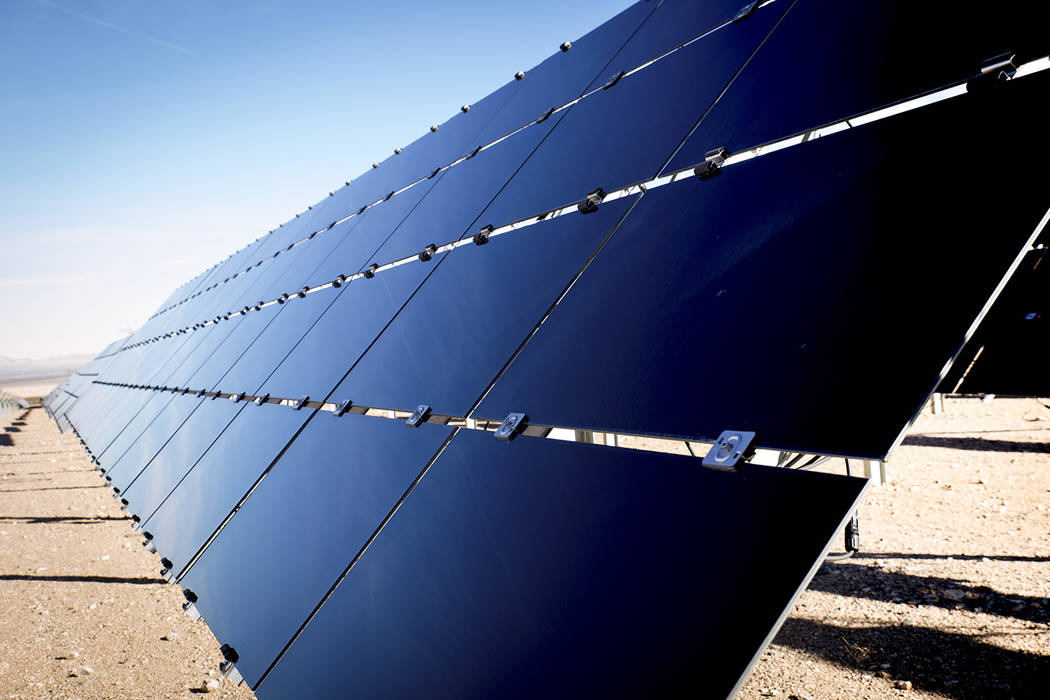
NextEra Energy Resources, the company behind the proposed Yellow Pine Solar Project 10 miles southeast of Pahrump, said that it will conduct vegetation studies this fall that could result in transplantation of individual species.
One of the main concerns voiced by conservationists has been the effect of the 250-megawatt Yellow Pine Solar Project on desert tortoise habitat. The desert tortoise is listed as a threatened species under the Endangered Species Act.
Bryan Garner, manager of communications at NextEra Energy Resources, said in an email that there is “no known data” on what plant species occur on site and at what densities.
“Vegetation studies will be completed this fall to determine what species occur on site and appropriate mitigation will be incorporated into the NEPA (National Environmental Policy Act) process, which could include transplanting individual species if determined appropriate,” Garner said.
Kevin Emmerich, co-founder of the nonprofit Basin and Range Watch, said the development would be located on one of the remaining good quality undisturbed desert tortoise habitats in the Mojave Desert.
“The project will be built in or next to a recently approved BLM Desert Tortoise Translocation Area – a region designated to move other displaced desert tortoises too. It seems ironic that they may allow NextEra to bulldoze that now,” Emmerich said in an email statement. “With the new urban growth boom happening in Las Vegas now and a Clark County resolution that requests to turn over 40,0000 acres of desert tortoise habitat on public lands to developers, we think that solar energy should be placed on all the rooftops of these new housing units rather than on pristine desert habitat.”
Garner said that impacts to the desert tortoise will be evaluated through the NEPA process and the Endangered Species Act, Section 7 process.
“Any necessary mitigation measures, including translocation, will be implemented as required through those processes,” Garner said.
On its website, Basin and Range Watch also said that thousands of hundred-year-old Mojave yuccas and Joshua trees will be “shredded and mulched” to free the area needed for construction of the solar plant.
The project would occupy 9,290 acres of BLM land in Clark County at the intersection of Nevada State Route 160 and Tecopa Road and would be located in the area that crosses the Old Spanish National Historic Trail, a historical trade route that goes up to Emigrant Pass and leads into California.
“The project would create a huge visual eyesore. It would be located near the historic Old Spanish Trail and along the Old Spanish Trail Highway, which is a scenic route for visitors to take from Death Valley National Park to Las Vegas,” Emmerich said.
The selected site is adjacent to the transmission which Garner said allows the project to be built “without requiring the construction of long expanses of new transmission lines.”
Garner said other features of the site that made it attractive are its large size with flat topography and its substantial distance from any residential or other regulatory structure.
“These site features allow us to place the final project footprint in the least impactful portion of the application area to reduce any potential resource conflicts,” Garner said.
The company already operates two projects in Nevada: the 250-megawatt Silver State South photovoltaic solar project near Primm and the 20-megawatt Mountain View photovoltaic solar project near Apex. Garner said Yellow Pine’s photovoltaic solar technology is similar to both of these sites, however, it would feature a new component in battery storage which will allow the project to store excess energy during the day and discharge it during peak times when the solar resource is not available.
Garner didn’t specify who would buy the energy from the project, but mentioned that NextEra is currently talking to “a number of potential customers.”
Public comment period
NextEra is currently going through the public comment period, as part of the Bureau of Land Management’s NEPA process. Two public scoping meetings took place in June Pahrump and Las Vegas.
When asked about the feedback that Yellow Pine received from the public, Garner acknowledged that there have been some comments regarding resource concerns, but said that the general response has been “supportive,” due to the company ability “to adjust the project footprint to reduce potential impacts as well as the addition of battery storage so the project output period can be extended.”
Following the public comment period, the Bureau of Land Management will review and respond to the comments it receives and prepare a draft Environmental Impact Statement which will be published and available for public review.
Written comments may be mailed to the BLM, Southern Nevada District, Renewable Energy Project Manager, 4701 N. Torrey Pines Drive, Las Vegas, NV 89130, or emailed to blm_nv_sndo_yellowpine@blm.gov
The 90-day public comment period closes on Aug. 28.